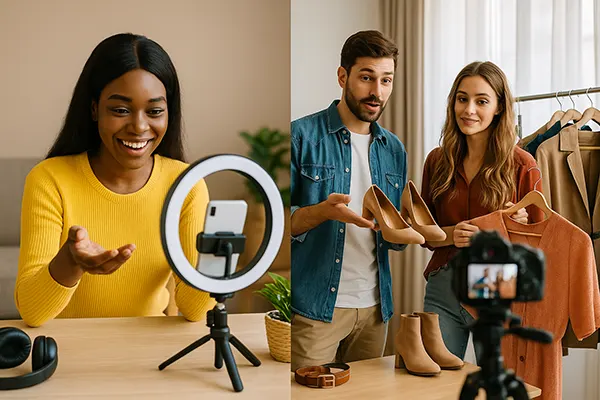Micro-Influencers vs. Macro-Influencers: ROI in SMM Campaigns

In the ever-evolving landscape of social media marketing (SMM), businesses constantly seek the highest return on investment (ROI) for their promotional campaigns. A pivotal decision in this strategy involves choosing between micro-influencers and macro-influencers. While both categories offer unique benefits, understanding which yields better ROI is essential for effective campaign planning in 2025.
Cost-Efficiency and Audience Engagement
Micro-influencers, typically individuals with 10,000 to 100,000 followers, often charge significantly less per post than macro-influencers. For small and medium-sized businesses, this lower cost barrier allows access to high-quality promotional opportunities without exhausting the budget. Additionally, micro-influencers usually enjoy higher engagement rates, as their followers often view them as more relatable and trustworthy.
On the other hand, macro-influencers—those with hundreds of thousands to millions of followers—command premium rates for content promotion. Despite their wide reach, their engagement per post can be lower due to a broader and more diluted audience. This may affect the effectiveness of targeted campaigns, especially those aiming at niche markets or localised outreach.
Recent studies indicate that campaigns with micro-influencers often achieve better cost-per-engagement (CPE) metrics. This makes them a strategic choice for marketers seeking quality interaction over sheer numbers.
Authenticity and Conversion Potential
Micro-influencers often maintain a closer, more personal relationship with their audience. Their content tends to reflect authentic lifestyle endorsements rather than scripted ads, which can significantly enhance conversion rates. This authenticity is a key driver of consumer trust and decision-making in 2025, particularly among Gen Z and Millennial audiences.
Macro-influencers, while offering impressive visibility, may struggle to build similar authenticity. Their content is often perceived as commercialised, which can reduce its persuasive power. Consumers today are increasingly aware of sponsored content and are more responsive to genuine recommendations.
Thus, while macro-influencers are effective for brand awareness campaigns, micro-influencers excel in generating meaningful actions, such as clicks, sign-ups, and purchases, contributing to a stronger ROI in specific campaign types.
Targeting Capabilities and Niche Marketing
Micro-influencers are typically embedded in niche communities—fitness, tech gadgets, vegan lifestyle, and more—making them ideal for highly targeted marketing. Their in-depth knowledge and interaction within these specific groups allow brands to tap into well-defined, loyal audiences.
By contrast, macro-influencers tend to appeal to broader demographics, which may dilute the effectiveness of targeted messaging. Their audience composition is often too diverse, making it harder to craft focused campaigns that resonate with a particular segment.
Brands focusing on niche products or regional services benefit more from collaborating with micro-influencers. These partnerships can drive higher engagement from a smaller but highly relevant audience, making each marketing dollar work harder.
Data-Driven Decision Making in 2025
In 2025, SMM tools offer advanced analytics to track influencer campaign performance with granularity. Marketers can now measure ROI not only by likes or shares but by deeper metrics like lead generation, conversion rates, and customer lifetime value.
This data supports the strategic use of micro-influencers for bottom-funnel marketing goals. Their ability to drive purchases or subscriptions is more easily measurable and often more impactful than macro-level visibility alone.
Consequently, data supports a trend where micro-influencer campaigns deliver superior ROI across various industries—from fashion to fintech—when precise targeting and engagement quality are prioritised.

Long-Term Partnerships and Brand Loyalty
Micro-influencers are often more open to long-term collaborations with brands, which can lead to stronger brand identity and customer loyalty. These ongoing relationships help create consistent messaging and deepen consumer connections over time.
Macro-influencers, due to their high demand, may engage in shorter, transactional partnerships. While these can offer short bursts of visibility, they rarely contribute to lasting consumer relationships or sustained brand affinity.
In 2025, audiences value consistency and recurring appearances of a brand within influencer content. Micro-influencers can provide this continuity, resulting in better audience retention and repeat purchase behaviour.
Scalability and Campaign Flexibility
While macro-influencer campaigns are often single-strike initiatives, micro-influencer strategies allow for scalable deployment. Brands can partner with dozens or hundreds of micro-influencers simultaneously to amplify their message organically.
This flexibility enables marketers to test different messaging angles and demographics in real time, adjusting the campaign based on live feedback and analytics. Such adaptive strategies are crucial in today’s agile marketing environments.
Overall, micro-influencer marketing emerges as a more sustainable, ROI-positive tactic in social media strategies that aim for deeper engagement and real consumer action rather than passive impressions.
